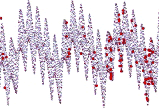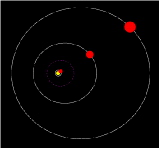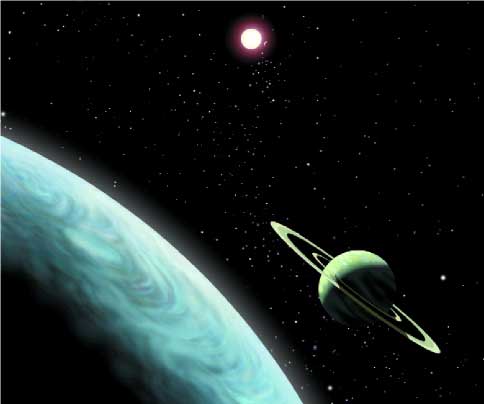Detecting Extrasolar Planets
Careful measurements of tiny shifts in spectral lines--the result of the Doppler effect--allow scientists to identify stars that might be home to planetary systems. In the case of Upsilon Andromedae, variations in the velocity of the star's rotation (graph at right) strongly suggest that a trio of planets orbits this star, which is in the constellation Andromeda.
The smallest body, at three-fourths the mass of Jupiter, orbits so near the star that its "year" is only 4.6 days long. The gravitational influence of this sidekick causes the star to buzz up and down in the envelope of its longer-period cycles. The middle planet, twice the mass of Jupiter, causes the star to wobble with a period of about 242 days. The outermost planet, at about four times Jupiter's mass, lumbers around the star in about 3.5 years. The presumed orbits are plotted at right, with the orbit of Earth (dotted line) included for reference.
Below is an artist's rendition of what this extrasolar system might look like from behind the outermost planet. |

 |

|
|
|
on our ATM cards. The links among these seemingly diverse phenomena extend electromagnetism's reach into every niche of the cosmos and every part of our lives.
Those links took time to unveil. In 1820, the Danish physicist Hans Christian Oersted  first demonstrated that an electric current flowing through a wire made a magnetized compass needle swing around. That is, a moving electric current created a magnetic field. A decade later, the English physicist Michael Faraday first demonstrated that an electric current flowing through a wire made a magnetized compass needle swing around. That is, a moving electric current created a magnetic field. A decade later, the English physicist Michael Faraday  proved the reverse: A magnet moving through a coiled wire induced an electric current in the wire. This pair of results demonstrated the inextricable ties between electricity and magnetism. Not until the 1860s, however, did anyone make the leap to add light to that pairing. The Scottish physicist James Clerk Maxwell proved the reverse: A magnet moving through a coiled wire induced an electric current in the wire. This pair of results demonstrated the inextricable ties between electricity and magnetism. Not until the 1860s, however, did anyone make the leap to add light to that pairing. The Scottish physicist James Clerk Maxwell  theorized that light waves stem from fluctuating electric fields and magnetic fields that stream together through space. Changes in the magnetic field generated a changing electric field, and vice versa, as Oersted's and Faraday's research showed. These mutual fields, oriented perpendicular to each other, moved at the speed of light: 186,282 miles per second theorized that light waves stem from fluctuating electric fields and magnetic fields that stream together through space. Changes in the magnetic field generated a changing electric field, and vice versa, as Oersted's and Faraday's research showed. These mutual fields, oriented perpendicular to each other, moved at the speed of light: 186,282 miles per second  . According to Maxwell's equations, electromagnetic waves moved in the same way as the types of periodic waves that travel along a snapping rope or the rippling surface of a pond. . According to Maxwell's equations, electromagnetic waves moved in the same way as the types of periodic waves that travel along a snapping rope or the rippling surface of a pond.
Maxwell's work cemented the relationship of light, electricity, and magnetism. Other than the omnipresent waves of light around us, electricity is the most apparent of these in our daily lives. The carrying units of electricity are electrons, the negatively charged particles so important in quantum mechanics. Free electrons  are tiny. A billion trillion of them weigh just a millionth as much as a paper clip. This makes the power of their electrical charge all the more impressive. Ounce for ounce, electromagnetic power is 100 billion times stronger than the weak nuclear force and 40 orders of magnitude stronger than gravity. For example, the electrical needs of a four-bedroom home for an entire year require less than one-thirtieth of an ounce of electrons are tiny. A billion trillion of them weigh just a millionth as much as a paper clip. This makes the power of their electrical charge all the more impressive. Ounce for ounce, electromagnetic power is 100 billion times stronger than the weak nuclear force and 40 orders of magnitude stronger than gravity. For example, the electrical needs of a four-bedroom home for an entire year require less than one-thirtieth of an ounce of electrons  . If the electrons . If the electrons  from 1 cubic centimeter of the Space Shuttle's nose cone were moved down to the launch pad, the extra electrical force at the pad would prevent the shuttle from lifting off. Just 2 pounds of electrons from 1 cubic centimeter of the Space Shuttle's nose cone were moved down to the launch pad, the extra electrical force at the pad would prevent the shuttle from lifting off. Just 2 pounds of electrons  clumped together on the far side of the Moon would overwhelm Earth's gravitational pull and tear the Moon from its orbit. These things don't happen, however, because a positively charged proton exists for every negatively charged electron. It's nearly impossible to create a big surplus of either because nature hates an imbalance of electrical charge. clumped together on the far side of the Moon would overwhelm Earth's gravitational pull and tear the Moon from its orbit. These things don't happen, however, because a positively charged proton exists for every negatively charged electron. It's nearly impossible to create a big surplus of either because nature hates an imbalance of electrical charge.
|

